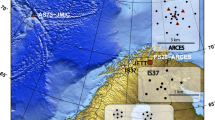Abstract
Two OBS arrays were deployed in the southern Okinawa Trough. Some of the OBS records revealed many earthquakes with intensive T waves but ambiguous body waves. A new method using T waves for epicenter locating was developed that was found to be as precise as the body wave method for locating epicenters when T waves are clearly recorded.
Similar content being viewed by others
References
Bada, H., Den, N., Iizuka, S. et al., 1988. Explosion seismic observations in and around Suruga Bay by the new pop-up type ocean bottom seismometers.Bull. Inst. Oceanic. Res. and Develop., Tokai Univ. 9: 45–53.
Hamada, N., 1985. T waves recorded by ocean bottom seismographs off the south coast Tokai area central Honshu, Japan,J. Phys. Earth. 33: 391–410.
Hirata, N. and Matsu'ura, M., 1987. Maximum-likelihood estimation of hypocenter with origin time eliminated using nonlinear inversion technique.Phys. Earth. Planet. Inter. 47: 50–61.
Hirata, N., Kinoshita, H., Katao, H. et al., 1991. Report on DELP 1988 cruises in the Okinawa Trough, Part 3: Crustal structure of the southern Okinawa Trough.Bull. Earthquake Res. Inst. Univ. Tokyo 66: 37–70.
Matsuda, N., Fujii, T. and Kinoshita, H., 1986. A pop-up type ocean bottom seismograph with geophones and a hydrophone for the study of crustal structures.Prog. Abstr. Seismol. Soc., Japan 2: 241 (in Japanese).
Matsu'ura, M., 1984. Bayesian estimation of hypocenter with origin time eliminated.J. Phys. Earth 32: 469–483.
Nagumo, S., Kasahara, J., Koresawa, S. et al., 1982. Acoustic release ocean bottom seismometer (ERI-AR81).Bull. Earthquake Res. Univ. Tokyo 57: 125–132.
Nagumo, S., Kinoshita, H., Kasahara, J. et al., 1986. Report on DELP 1984 cruise in the middle Okinawa Trough, Part II, Seismic structural studies.Bull. Earthquake Res. Univ. Tokyo 61: 167–202.
Shimamura, H. and Asada, T., 1975. T waves from deep earthquakes generated exactly at the bottom of deep-sea trenches.Earth. Planet. Sci. Lett. 27: 137–142.
Talandier, J. and Okal, E., 1979. Human perception of T waves: the June 22, 1977 Tonga earthquake felt on Tahiti.Bull. Seismol. Soc. Am. 69: 1487–1496.
Yamada, T., Asada, T. and Shimamura, H., 1981. A pop-up ocean bottom seismograph,Prog. Abstr. Seismol. Soc., Japan 2: 126 (in Japanese).
Author information
Authors and Affiliations
Rights and permissions
About this article
Cite this article
Zuo-lin, C., Zuo-sheng, Y. & Naoshi, H. A method for epicenter locating by using T waves. Chin. J. Ocean. Limnol. 12, 255–261 (1994). https://doi.org/10.1007/BF02845171
Received:
Issue Date:
DOI: https://doi.org/10.1007/BF02845171




